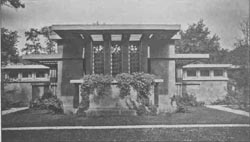William Allin Starrer. The Frank Lloyd Wright Companion. Chicago and London: University of Chicago Press,1993. Pp. 492 with photographs, floor plans and index. $75. (cloth). Anthony Alofsin. Frank Lloyd Wright: The Lost Years, 1910-1922; A Study of Influence. Chicago and London: University of Chicago Press, 1993. Pp. 397 with photographs, illustrations, appendices, notes, bibliography and index. $55.(cloth). Can a single volume about Frank Lloyd Wright cover his entire executed output of 433 buildings, providing for each a photograph (historic or contemporary),a short and pertinent history of the building and the client, and asense of the structure'spersonality, plus a basic floor plan? Yes, William Allin Storrer'sCompanion does allthis and more. This handsome oversized book provides a definitive composite picture of his career. Storrer, alreadywell-known for his1974 study of The Architecture of Frank Lloyd Wright, has done a mighty service for Wright enthusiasts. Based on personal visits to each site, he documents Wright's vastoeuvre, from his first executed design (the 1886 interior of Silbee's Helena Valley Unity Chapel near Taliesin, Spring Green, Wis.) to his last completed work (the 1959-1966 Lykes residence in Phoenix). Storrer includes the full range of projects, from small vacation cottages to giant statements of Wright's second Golden Period (1937-1959). The genesis of each building is described, bringing together design, use and client. Innovative stylistic approaches and daring engineering methods arestressed. To whet your appetite for the incomparable richness of this book, here are a few choice items from the enormous body of information it provides. First, there are historic photographs of now demolished"bootleg houses," so-called because Wright did them secretly while under contract to Dankmar Adier and Louis Sullivan. Examples include the MacHarghome and the Harlan residence interior. From Oak Park there are early photos of the Nathan Moore house and the interior of the George Smith home as well as rare interior shots of the Fricke residence. From elsewhere there are assembled a stunning photograph of the New York City exhibition for the Universal Portland Cement Company, a now demolished project which anticipated Chicago's Midway Gardens; the 1911 Lake Geneva (Wisconsin) hotel, torn down in 1970; theFuller residence of 1951, tragically destroyed by Hurricane Camille in 1969; and the Plaza Hotel "Taliesin East" apartment remodeling project in New YorkCity in 1954. This indispensable resource celebrates Wright's amazing productivity, endless variety and remarkable genius. Its encyclopedic quality makes it an invaluable tool for understanding the master, whom most critics and laymen regard as the pre-eminent architect of our time. If Storrer's book is invaluable for its overview of everything Wright built, the second book under review here represents a different kind of contribution to thegrowing field of Wright studies. Once in a while, a new book on Wright appears that tries to describe the "lost years" of 1910-1922, the most elusive phase of his career spanning seven decades. This period of Wright's life was fraught with insecurity. He was beset by personal problems (marital, social and financial), a lack of positive professional direction and, most of all, apprehension that time had passed him by. Anthony Alofsin, director of the Center for Architecture and Design at the University of Texas-Austin, researched the record of these years in the actual locations where Wright lived,worked and traveled, and as a result has
July 1994/Illinois Issues/27 Summer Book Section uncovered many matters previously ignored or passed over lightly. New facts have emerged that help to explain Wright's behavior and the contributing circumstances during this mysterious decade. Until now, the nature and import of Wright's travels to Berlin and else where in Europe at this time have seemed arcane. For example, why are there no photographs of Wright and his companon Mamah Cheney during this interlude? Alofsin's answer: Wright preferred a lowprofile because of adverse publicity about the collapse of his marriage preceding his European trips. Wright went abroad in order to establish a European foothold and to begin production of the Wasmuth Folio in Berlin. Once the Folio achronological reproduction of Wright's designs up to 1910 brought him recognition in Germany, broader European acclaim would follow. Alofsin details Wright's maneuvering to stabilize the Folio operation, which involved gaining artistic as well as financial control. Wright's agenda while abroad included visits to leading Viennese architectural rebels who influenced his next profesional thrust by inspiring his movement toward exotic primitivism. A basic question about this influence remains: Did Wright's interest in primitivism awakenor reawaken as he travelled in Europe? The accepted view is that he first became aware of such influences at the 1893 Columbian Exposition in Chicago. Yetno evidence of this appears in his architecture except in his use of the Japanese idiom. These other exotic influences appear later after his European travels. Regardless of Wright's admissions ordenials, his European experience provided a powerful impetus to his fluctuating career. This period of exposure to continental culture, ancient and medieval art, Viennese architectural rebels and the German intelligentsia introduced him to new frontiers of expression which dramatically changed his outlook on hiswork and his life. Alofsin's book enriches our understanding of this decade and its impact on Wright's evolving vision. Lyman Shepard is a founding board member of the Frank Lloyd Wright Home and Studio Foundation in Oak Park. He has served as a tour guide at the site for 20 years. In addition, he is a past president of the Unity Temple Restoration Foundation.
|
|||||||||||||||

